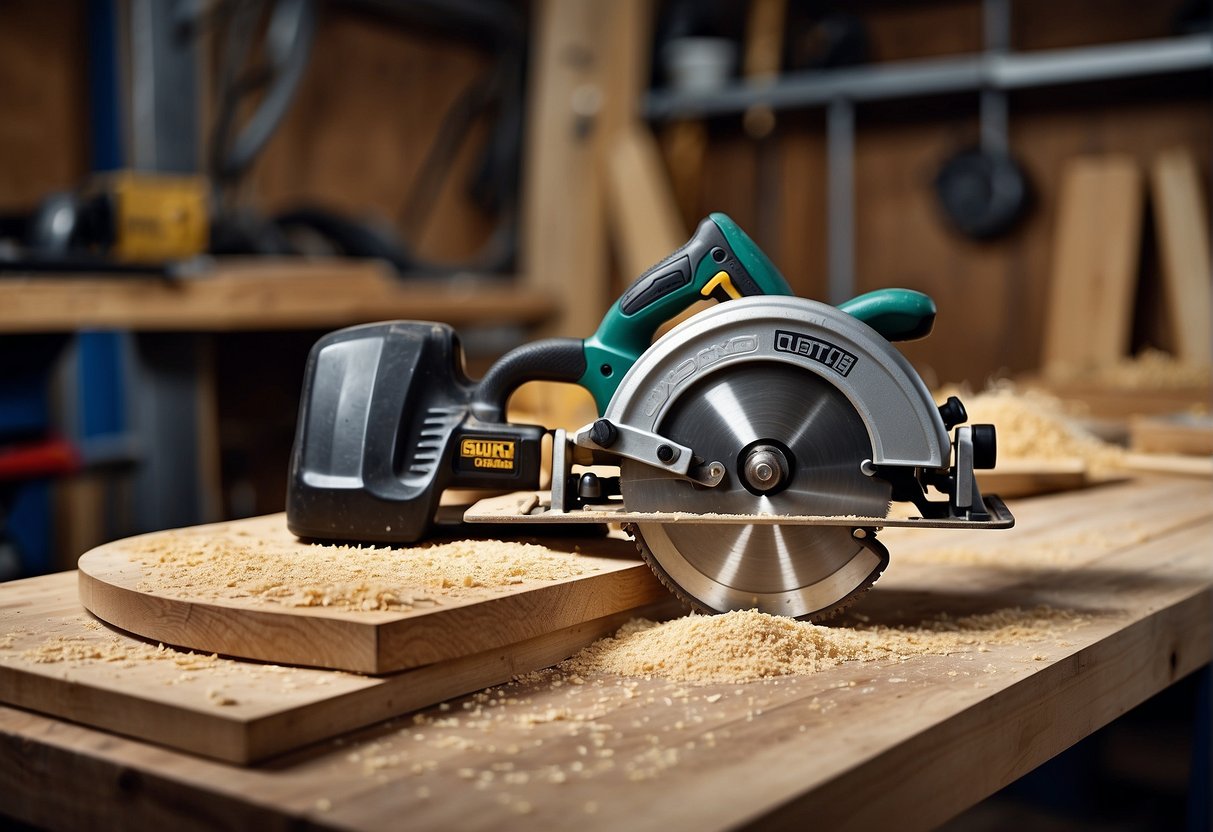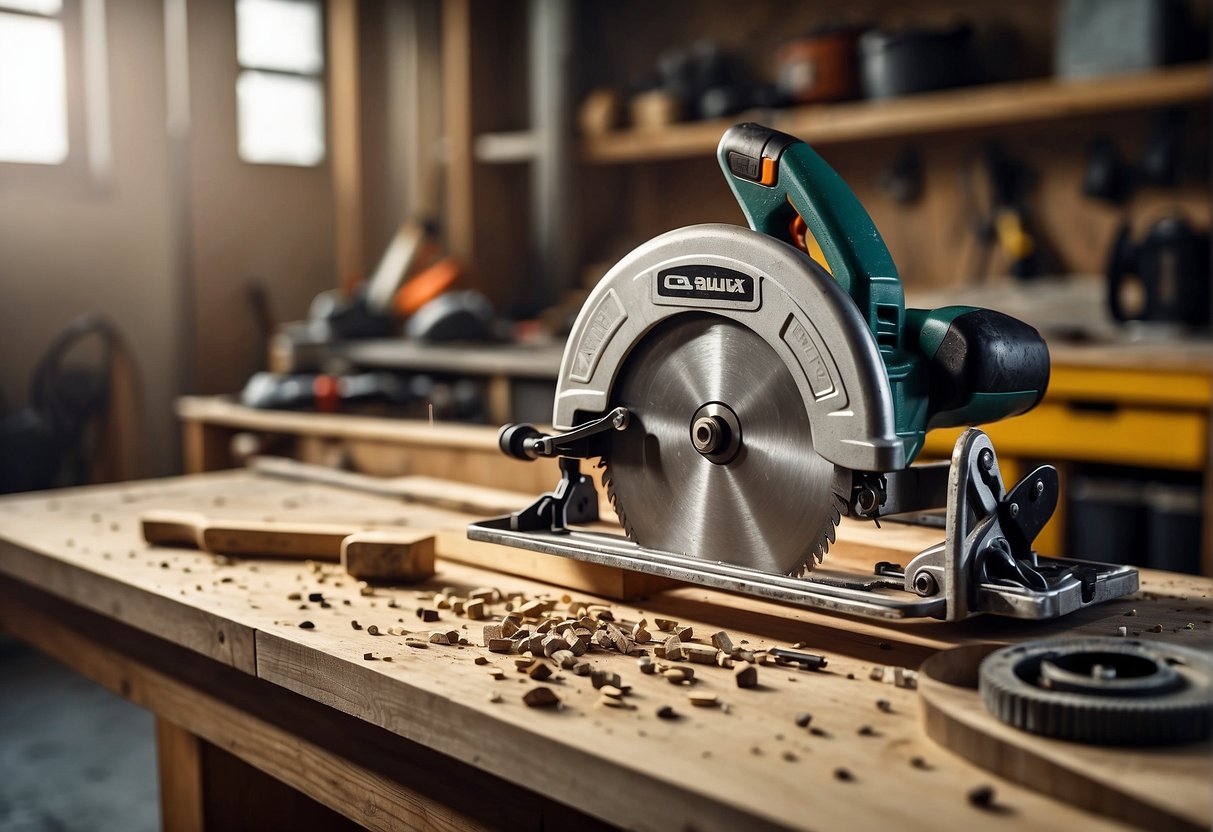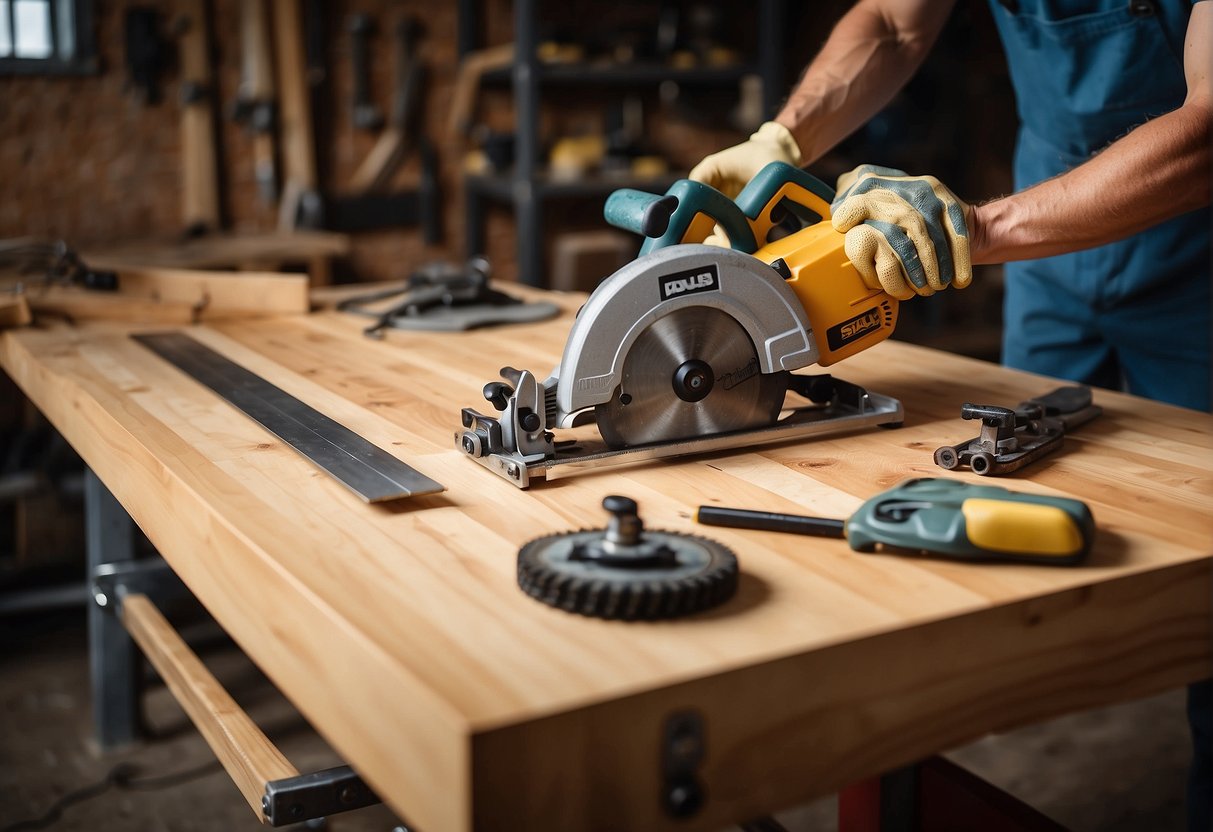Circular saws and skill saws are two of the most common cutting tools used by both professional contractors and DIY enthusiasts. While these two saws may seem similar at first glance, they have distinct differences that make them better suited for specific applications.
A circular saw is a handheld power tool that uses a circular blade to cut through a variety of materials, including wood, metal, and plastic. One of the biggest advantages of a circular saw is its versatility. With the right blade, a circular saw can be used to make straight or curved cuts in a wide range of materials. On the other hand, a skill saw is a specific type of circular saw that is manufactured by the SKIL brand. While a skill saw is technically a circular saw, it is often used to refer specifically to SKIL’s line of saws.
Key Takeaways
- Circular saws are versatile and can be used to make straight or curved cuts in a variety of materials.
- Skill saws are a type of circular saw manufactured by SKIL.
- Choosing the right saw for your project depends on the specific application and materials being used.
Understanding Circular Saws and Skill Saws
History and Evolution
As power tools, circular saws and skill saws have a long and fascinating history. The first electric handsaw was invented by Edmond Michel in 1923, and the Michel Electric Handsaw Company later became Skil, one of the most popular brands of circular saws today. Over the years, circular saws have evolved to become more powerful, efficient, and versatile, with a range of different designs and types to suit different needs.
Design and Types
Circular saws come in two main designs: worm drive and sidewinder. Worm drive saws have the motor positioned behind the blade, while sidewinder saws have the motor positioned alongside the blade. There are also cordless circular saws, hypoid saws, and other types of circular saws available. Skill saws are a specific type of circular saw that are often associated with the Skil brand, but the term can also refer to any handheld power saw with a flat, round blade that spins to cut through wood and other materials.
Key Differences
The main differences between circular saws and skill saws are in the branding and terminology. Skill saws are a specific type of circular saw that are often associated with the Skil brand, while circular saws refer to a broader range of power saws with a round, rotating blade. However, there are also differences in the design and types of circular saws available, such as worm drive saws and sidewinder saws, as well as differences in blade size and power source.
Branding and Terminology
The Skil brand has become synonymous with skill saws, similar to how “Kleenex” is often used to refer to facial tissues. However, there are many other brands of circular saws available, such as DeWalt, Makita, and Bosch. When shopping for a circular saw, it’s important to consider the specific features and capabilities of each model, regardless of the brand name.
Common Uses in Woodworking
Circular saws and skill saws are essential tools for woodworking, allowing for precise cuts in plywood, lumber, and other materials. They are often used in conjunction with other power tools, such as table saws and miter saws, to create a range of different types of cuts for carpentry and other woodworking projects.
Safety and Handling
When using a circular saw or skill saw, it’s important to take precautions to ensure safety. This includes wearing protective gear such as gloves and eye protection, as well as using the blade guard and other safety features on the saw. It’s also important to handle the saw properly and follow all instructions for use.
Maintenance and Longevity
To ensure the longevity of a circular saw or skill saw, it’s important to perform regular maintenance and upkeep. This includes keeping the blade sharp and clean, checking the motor and other components for wear and tear, and storing the saw properly when not in use.
Price and Budget Considerations
Circular saws and skill saws come in a range of different prices, depending on the brand, features, and capabilities. It’s important to consider your budget and specific needs when shopping for a saw, and to choose a model that offers the best value for your money.
Comparing Performance and Applications
As a woodworker or carpenter, choosing the right saw for your project can be a daunting task. Among the most popular saws are circular saws and skill saws. In this section, I will compare the performance and applications of these two types of saws.
Power and Cutting Ability
Circular saws and skill saws are both powerful tools that can make quick work of cutting wood, metal, plastic, and even concrete. However, circular saws tend to be more powerful and faster than skill saws due to their larger blades and higher RPMs. Circular saws are ideal for making long, straight cuts, while skill saws are better for precision cutting and plunge cuts.
Portability and Convenience
When it comes to portability and convenience, skill saws have the upper hand. Skill saws are typically lighter and more compact than circular saws, making them easier to carry around and use in tight spaces. Additionally, skill saws are available in both corded and cordless options, while circular saws are typically corded only.
Material Versatility
Both circular saws and skill saws are versatile tools that can cut a wide range of materials, including wood, metal, plastic, and concrete. However, circular saws are better suited for cutting thicker and tougher materials, while skill saws are better for cutting thinner and more delicate materials.
Professional vs DIY Use
Circular saws are generally considered to be more of a professional tool, while skill saws are a popular choice among DIY enthusiasts and DIYers. Circular saws are typically more expensive and offer more advanced features, while skill saws are more affordable and easier to use.
Brand-Specific Offerings
When it comes to brand-specific offerings, Skil is the most well-known and popular brand of skill saws, while Makita and DeWalt are popular brands of circular saws. Each brand offers different features and capabilities, so it’s important to choose the brand that best fits your needs and budget.
In summary, choosing between a circular saw and a skill saw depends on your specific needs and the type of project you are working on. Both saws have their own unique advantages and disadvantages, so it’s important to consider these factors carefully before making a decision.
Pros and Cons of Circular Saws vs Skill Saws
When it comes to cutting wood, both circular saws and skill saws have their advantages and limitations. As someone who has used both types of saws, I can confidently say that each has its place in the workshop. In this section, I will discuss the pros and cons of circular saws vs skill saws.
Advantages of Circular Saws
Circular saws are versatile tools that can make a variety of cuts, including rip cuts and crosscuts. They are also faster than skill saws, making them ideal for larger projects that require speed. Additionally, circular saws have brand recognition, which means that there are many accessories and replacement parts available for them.
Advantages of Skill Saws
Skill saws, or sidewinder saws, are a specific type of circular saw that has its motor mounted perpendicular to the blade. This design makes them more compact and lighter than other types of circular saws, which is an advantage when working in tight spaces. Skill saws are also known for their precision, making them ideal for making accurate cuts.
Limitations of Circular Saws
One of the main limitations of circular saws is their weight. They are heavier than skill saws, which can make them tiring to use for long periods. Additionally, circular saws can have brand-specific constraints, meaning that accessories and replacement parts may be harder to find for certain brands.
Limitations of Skill Saws
While skill saws are lighter and more compact than other types of circular saws, they are not as versatile. They are best suited for making straight cuts in wood and are not ideal for making bevel cuts or cutting thicker materials. Skill saws also have limitations when it comes to ergonomics, as their handle is located further back on the tool, which can make them harder to control.
In conclusion, both circular saws and skill saws have their pros and cons, and choosing the right tool for the job depends on the project at hand. If speed and versatility are important, a circular saw may be the best choice. If precision and ergonomics are more important, a skill saw may be the way to go.
Selecting the Right Saw for Your Project
As a DIY enthusiast, I know how important it is to select the right saw for your project. Choosing between a circular saw and a skill saw can be confusing, but there are several factors to consider before making a decision.
Factors to Consider
When selecting a saw, it is important to consider the type of project you will be working on. For example, if you are building furniture, a table saw or miter saw may be a better choice than a circular or skill saw. However, if you are working on a construction project, a circular or skill saw may be more appropriate.
Another important factor to consider is the blade size. Circular saws typically have larger blades than skill saws, which can make them more suitable for larger projects. However, skill saws are often more maneuverable, making them a better choice for smaller, more intricate cuts.
Types of Projects and Saws
As mentioned above, the type of project you are working on will determine the type of saw you need. For example, if you are building a deck, a circular saw may be the best choice. However, if you are working on a smaller project, such as building a birdhouse, a skill saw may be more appropriate.
Corded vs Cordless Options
Another factor to consider is whether you want a corded or cordless saw. Corded saws typically have more power, making them a better choice for larger projects. However, cordless saws are more portable and can be used in areas without access to electricity.
Ergonomics and Ease of Use
When selecting a saw, it is important to consider the ergonomics and ease of use. A saw with a comfortable handle and good balance will be easier to use for extended periods of time. Additionally, a saw with an easy-to-use blade guard and other safety features will help prevent accidents.
Accessories and Upgrades
Finally, it is important to consider the accessories and upgrades available for your saw. For example, a saw with a laser guide or LED light can make it easier to make accurate cuts. Additionally, upgrading to a higher-quality blade can improve the quality of your cuts.
In conclusion, selecting the right saw for your project requires careful consideration of several factors, including the type of project, blade size, corded vs cordless options, ergonomics and ease of use, and accessories and upgrades. By taking these factors into account, you can choose the saw that is best suited for your needs.
Conclusion
After comparing and contrasting the circular saw and the skill saw, it is clear that both tools have their own unique advantages and disadvantages. It ultimately comes down to personal preferences and the specific needs of the project at hand.
In terms of performance, both saws are capable of making accurate and precise cuts. However, the skill saw tends to be more powerful and can handle tougher materials, making it a better choice for heavy-duty jobs. On the other hand, the circular saw is more lightweight and portable, making it easier to maneuver and use in tight spaces.
When it comes to durability, both saws are built to last. However, the skill saw is generally considered to be more durable due to its heavier construction and more robust design.
In terms of functions, both saws are versatile and can be used for a variety of tasks. However, the skill saw is better suited for cutting through thicker materials, while the circular saw is better for making precise cuts in thinner materials.
Based on my personal experience and research, I would recommend the skill saw for professionals and those who frequently work with heavy-duty materials. However, for the average DIYer or hobbyist, the circular saw is a more practical and cost-effective option.
Overall, both the circular saw and the skill saw have their own unique strengths and weaknesses. It is important to consider your specific needs and preferences before making a decision on which saw to use for your project.
Frequently Asked Questions
What are the primary differences between a circular saw and a Skilsaw?
A circular saw is a versatile handheld power tool equipped with a rotating blade designed to slice through a variety of materials, including wood, plywood, and medium-density fiberboard (MDF). On the other hand, a Skilsaw is a specific type of circular saw produced by the SKIL brand. The primary difference between the two is that a Skilsaw has a worm drive, while a circular saw has a direct drive. The worm drive provides more torque and power, making it ideal for heavy-duty cutting tasks.
Which saw is more suitable for a beginner, a circular saw or a Skilsaw?
For beginners, a circular saw is a better option than a Skilsaw. Circular saws are more lightweight, compact, and easier to handle than Skilsaws. They are also less expensive and more widely available. However, if you plan to work on heavy-duty cutting tasks, a Skilsaw might be a better option.
How does a Skilsaw compare to a table saw in terms of functionality?
A Skilsaw and a table saw are two different tools that serve different purposes. A Skilsaw is a handheld circular saw used for cutting through wood, while a table saw is a stationary saw that is used for making precise cuts on large pieces of wood. While a Skilsaw is portable and versatile, a table saw is more accurate and powerful.
What are the specific uses for a Skilsaw in woodworking or construction?
A Skilsaw is a versatile tool that can be used for a variety of cutting tasks in woodworking or construction. It is ideal for cutting through thick pieces of wood, making angled cuts, and cutting through materials like plywood and MDF. Skilsaws are commonly used for framing, decking, and other construction projects.
When should one opt for a circular saw over a jigsaw or miter saw?
A circular saw is a good option when you need to make long, straight cuts in wood or other materials. A jigsaw, on the other hand, is used for making curved cuts or cutting out intricate shapes. A miter saw is used for making precise angle cuts. If you need to make long, straight cuts, a circular saw is the best option.
What are the safety precautions to consider when operating a circular saw?
When operating a circular saw, it is important to wear eye and ear protection, as well as gloves and a dust mask. Always make sure the blade is properly tightened and the guard is in place before use. Keep your fingers away from the blade and never reach under the saw while it is running. Always use the saw on a stable surface and make sure the material you are cutting is secure.

Hi, I’m Sal Muller of Tooltrip.com. My DIY experience led me to understand essential power tools for home projects. Tooltrip.com guides enthusiasts and professionals in choosing right tools for any job. I provide concise top tool reviews for easier, efficient DIY.




